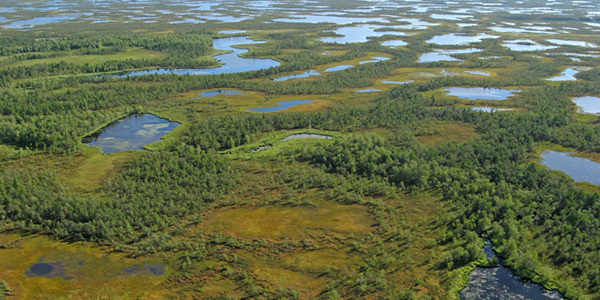Research to focus on microbes in peat moss
 (Download Image)
Peat moss, also called sphagnum, carpets the surface of peatlands. This type of wetland locks up huge amounts of carbon in the form of thick, peat soil deposits. When peat is broken down by microbes, greenhouse gases — methane and carbon dioxide — are produced.
(Download Image)
Peat moss, also called sphagnum, carpets the surface of peatlands. This type of wetland locks up huge amounts of carbon in the form of thick, peat soil deposits. When peat is broken down by microbes, greenhouse gases — methane and carbon dioxide — are produced.
Mention "peat moss" and many people will conjure up the curly brown plant material that gardeners use. "Oh, the thing you get at Home Depot" is a common reaction Joel Kostka receives when he mentions that he studies peat moss. His response: "Peat moss is a really cool plant that’s important to the global carbon cycle."
The National Science Foundation has just awarded Georgia Tech, and Lawrence Livermore (LLNL) and Oak Ridge national laboratories a $1.15 million, three-year grant to study the microbes in peat moss. The goal is to understand the microbiome’s role in nutrient uptake and the methane dynamics of wetlands and the impact of climate change on these activities.
Kostka, a Georgia Tech professor, is working with Jennifer Glass, an assistant professor at Georgia Tech; Xavier Mayali, a research scientist at LLNL; and David Weston, a staff scientist at Oak Ridge.
"It has been shown that microbes that live with peat moss help them to grow better by aiding their uptake of carbon and major nutrients such as nitrogen," Kostka said. "This project will explore which microbes help to keep peat moss plants healthy, how plants and microbes interact and how these relationships will be affected by climate change."
Peat moss, also called sphagnum, carpets the surface of peatlands.This type of wetland locks up huge amounts of carbon in the form of thick, peat soil deposits. When peat is broken down by microbes, greenhouse gases — methane and carbon dioxide — are produced. Methane is of particular interest, because when released to the atmosphere, it has a warming potential that is 21 times that of carbon dioxide.
Scientists hypothesize that environmental warming could cause peatlands to release a lot more methane, which in turn would accelerate climate change.
There is evidence suggesting that peatlands will produce more methane as the environment warms up. "Methanogens [methane-producing bacteria] don’t like the cold," Kostka said. "The warmer it gets, the better they are in producing methane."
Methane in peatlands bubbles up to the peat moss layer. Methane-consuming microbes in peat moss eat some of the gas released. In effect, microbes in peat moss comprise a biofilter that reduces the amount of methane reaching the atmosphere.
"We hypothesize that the methane-eating microbes in peat moss may crash as the climate gets warmer," Kostka said. As the climate gets warmer, microbes in peatlands produce more methane, while other microbes in peat moss become less able to consume the greenhouse gas. "We could get an explosion of methane, much more than we can predict," Kostka said.
At LLNL, Mayali will use NanoSims, an imaging mass spectrometer, to identify what microbes are eating the methane or fixing nitrogen. He will incubate microbe samples with substrates — methane, carbon dioxide and nitrogen — enriched in rare isotopes such as carbon-13 instead of the normally abundant carbon-12. Analysis by NanoSims creates isotope maps that enables detailed tracing of who did what.
"Our instrument is able to not only track what is eating the methane or fixing nitrogen from the air, but more importantly, how much and where it ultimately ends up, for example into the sphagnum plant versus being kept by the microbes," Mayali said.
Information about plant microbiomes is scant. Most plants whose microbiomes are being studied are crops, like corn and soybeans. "Few studies are available on plants that are environmentally important but not so economically important," Kostka said. "A lot of our work is to build better models for how these wetlands respond to climate change."
Glass will study the geochemical aspects of the peat moss microbiome. She will measure how fast peat moss microbes fix nitrogen and consume methane and identify the trace nutrients available to peat moss in the wetland.
"Because these peatlands receive most of their nutrient input from precipitation, they contain extremely low concentrations of some bioessential trace metals," Glass said. "We're interested in testing how trace nutrient availability impacts the growth of methane-cycling microbes exposed to warming temperatures."
Weston will use genetically characterized peat moss and microbial members to construct synthetic communities to test how host moss genes influence microbiome assembly and functioning. "Peat moss microbiomes are extremely complex with thousands of members with diverse metabolic capabilities," he said.
"To help determine the role of specific community member interactions," Weston added, "we will decompose the field system into simplified synthetic communities where community changes and nutrients can be accurately measured and subjected to precise environmental manipulations."
"We can engineer wetlands to encourage the growth of peat moss, but that’s not our goal," Kostka said. "We’re trying to figure out how the microbes help the plants grow better."
Contact
 Anne M. Stark
Anne M. Stark
[email protected]
(925) 422-9799
Related Links
National Science FoundationGeorgia Tech
Tags
Physical and Life SciencesFeatured Articles







